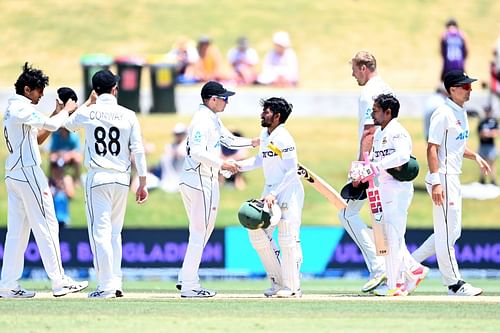
South Africa’s grit, Bangladesh’s dominance - what do they mean for Test Cricket?

It is early morning in New Zealand on January 5. The sun has still not risen in most parts of the world, including Bangladesh, a nation that expects a brighter sun rise that day. But the New Zealand and Bangladesh teams are out at the Bay Oval in Mount Maunganui for the fifth day of the first Test. The Kiwis are nine wickets down for 169 in the 74th over of their second innings.
Mehedy Hasan managed three dot balls against Trent Boult, making the latter impatient. The fourth ball was pitched wide of off-stump in a good length area and spun in sharply. Boult came down the track, sat on his knees and slogged it towards the deep mid-wicket region. Taijul Islam, on as a substitute fielder, dived backwards to complete a superb catch at the boundary. Ebadot Hossain ran and carried Islam in the air, with the entire Bangladesh team gathering at the boundary with that last wicket.
The reason? Their target to create history was just 40 runs. An hour-and-a-half later, Mushfiqur Rahim, Bangladesh’s senior-most player in the squad, guided the ball towards the backward point boundary for the winning runs, thus creating history!
Skip forward two days. On January 7 in South Africa, the sun is on the verge of going down. It had already gone down in several other parts of the world, including India – not only empirically, but morally as well.
After two sessions being washed out by rain, the officials allowed a maximum of 34 overs in the final session of the fourth day. The pundits believed that the match will be completed only on the fifth day.
But 27 overs and three balls later, Dean Elgar whipped Ravichandran Ashwin to the fence through mid-wicket. The Proteas skipper punched the air, punched the bat and then hugged Temba Bavuma. He then walked back to the pavilion with determination pouring out of his face as South Africa had just created history.
Bangladesh had never won a Test match against New Zealand in 15 previous attempts, but they did last week, that too in New Zealand. South Africa, meanwhile, had never defeated India at the Wanderers, but they did last week, that too by chasing down 240 for the first time in over the last 20 years.
So what do the two victories mean for Test cricket?
While Bangladesh’s victory over New Zealand can definitely be termed as an upset, South Africa’s triumph over India can't be branded one.
But such has been the dominance of India in Test cricket in recent years, coupled with the Proteas' rapid downfall, the hosts' victory against Team India could be debated as an upset.
However, it was South Africa’s best moment in the last three years, eclipsing their Test victories over Sri Lanka and West Indies. For Bangladesh, if the victory is measured on the Mercalli scale, it would break the scale.
The Tigers defeated the World Test Champions. So far, there have been subjective Test Champions. But since June 2021, the Kiwis have been crowned World Test Champions after they beat India in the World Test Championship (WTC) final. Not only did Bangladesh beat New Zealand, but they dominated four out of the five days.
For years, there has been a debate about the longest format of the game. Interest in Test cricket has evidently been reduced with the advent of T20 cricket and franchise-based leagues.
But just when it looks like Test cricket's time has ended, matches like these pull it right back up.
There have been several classic and nail biting matches in recent times. These two games, however, were not. After a point in time, you knew the direction in which it was headed. Yet, they were astonishing, entertaining and inspiring matches.
For Bangladesh, the win itself was astonishing. No one gave them a chance and they played without any expectations. Their senior pros Tamim Iqbal and Shakib-Al-Hasan were missing. Even if the duo played, Bangladesh would not have been considered a competition for the Blackcaps in New Zealand.
But the visitors found a star in Ebadot Hossain, who averaged 81.5 before the match - the worst for any bowler with more than 10 wickets. They also found a batting line-up that is capable of taking the team forward in the absence of Tamim and Shakib.
The victory would become more passionate when we remember the last time Bangladesh toured New Zealand. Their expedition was cut short due to the mosque shooting incident.
For Bangladesh, winning was a confirmation that they belong in the Test arena and can compete at the highest level.
For South Africa, on the other hand, it was a reassurance that they are evolving and not dwindling.
For quite a long time, South African cricket has been hit by racism, a lack of attractive compensation for its players and other administrative issues. But this win will give them confidence to fight the adversities.
The Proteas will also find inspiration in their leader Dean Elgar, who showed grit and determination. But while the game was poised, the situation was tailor-made for his not-so-good-looking, but determined approach.
He has often been compared to Graeme Smith, and has been termed a mini-biff. But that is true in more than one way. Elgar is not as tall or as broad as Smith. More significantly, he doesn’t have half the team Smith had. But that innings of 96* was as powerful as any.
The matches did not live up to the last over, or last hour, or last session, like the drawn Australia-England fourth Ashes Test. But they were special in their own way. While Bangladesh’s legacy of Test cricket was kept alive, South Africa’s had been resurrected.
The World Test Championship has already added much-needed impetus to the existence of the longest format of the game. However, these two victories for subjective underdogs have ensured that the competition has not died. 10 years down the future, it will not just be the big three (India, Australia and England) and New Zealand playing Test cricket.
For those who don’t understand cricket, Test matches are pieces of mockery. For those who understand, Test cricket is the purest format of the game. A format believed to be fading still keeps producing fantastic matches. A format believed to be dying, is actually far too young and alive.